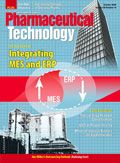Report From: Europe
Although the European Union's approval rates of biosimilars for market is increasing slower than expected, its approach may provide an example for other foreign markets.
In terms of numbers of approved drugs on the market, the European Union's four-year-old groundbreaking system for approving drugs similar to already approved biopharmaceutical products would appear to have had little impact to date. The EU amended its legislation relating to drug approvals in 2004 to lay out a legal framework for biosimilars. The European Medicines Agency (EMEA) has since clarified the amendment via a series of guidelines. Only five biosimilars, however, are available in the EU market thus far: two are for the human growth hormone somatropin and three are for epoetin alfa as an anemia treatment.

(ALEX BLOCH/GETTY IMAGES)
EMEA gave a positive opinion earlier this year for another four biosimilar drug for filgrastim, a granulocyte colony-stimulating factor (G-CSF) for the hematological disorder neutropenin. The opinions opened the market for biosimilars, which can be commercialized after the brand-name drug's patent expires.
The European Generic Medicines Association (EGA), representing manufacturers of off-patent drug and a strong supporter of the EU's biosimilars scheme, concedes that it may take another five years to show how successful the EU has been in providing patients with greater access to biopharmaceuticals.
"Some people may think that the system is slow because there're only five bio-similars on the market at the moment," says Suzette Kox, EGA's senior director for scientific affairs. "In fact, the European system is the fastest in the world. EMEA is first regulatory authority in the world to have a clear legal framework for the approval of biosimilars which ensures that they are products of a very high standard."
Biosimilars in the EU are different from "biogenerics," which have not been legalized in the region, because they are approved only after meeting rigorous criteria that establish comparability with the innovator drug or reference product. Unlike biogenerics, biosimilar drugs also have to undergo clinical trials to establish comparability and to demonstrate efficacy and safety.
Regulators have "to know more about the reference product because the biosimilar is better characterized due to the data required," explains Kox. "Data are submitted to the authorities which has never been seen before because of the advanced analytical techniques being applied."
Nonetheless, comparability is still a big issue in the marketplace. Companies marketing biosimilars want to emphasize their similarity to the original product, and companies promoting the reference products aim to highlight the differences.
"Biosimilars have demonstrated they have the same efficacy, safety, and quality, but they still may have different side effects, varying levels of concentration, and other differences," says Michael Leader, healthcare director at the European Association of Bioindustries (EuropaBio), representing research-based biopharmaceutical companies.
EGA has claimed that the marketing activities of companies defending innovator biopharmaceuticals are undermining the expansion of biosimilars, which currently have prices averaging around 20% below those of the reference product.
"Competitors to biosimilars have been adopting scare tactics," says Kox. "They have tried to weaken confidence in these products. We hear that some doctors have been holding back from prescribing them" as a result. These contrasting attitudes on comparability have been highlighted by differing views on the naming and labeling of biosimilars.
The EU's reference product producers argue that biosimilars should have a different international nonproprietary name (INN) within the World Health Organization's (WHO) naming system for therapeutic compounds. Because biosimilars are not 100% identical to the original products, they need a distinct INN, according to EuropaBio.
On the other hand, EGA is pushing for the INN system to acknowledge that the concept of comparability, which is used with original biopharmaceuticals as they go through process changes, be the same as the concept applied to biosimilars. If the concepts were the same, there would be no need for a distinctive INN designation for biosimilars.
WHO is currently reviewing this particular issue, the outcome of which will be a key component in pending guidelines to regulate biosimilars and biogenerics. The guidelines could determine whether the EU's approval procedure should become the basis for a harmonized global system for authorizing copies of off-patent biopharmaceuticals or whether less strict approaches should prevail.
Sean Milmo is a freelance science writer based in Essex, England.
